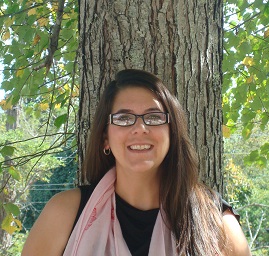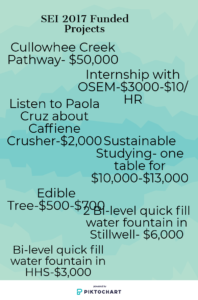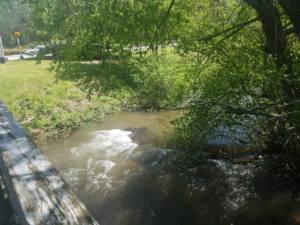Co-written with Hallie West
Much has changed at Western Carolina University since its inception in 1889, such as the number of students, curriculum, class sizes and more. Not surprisingly, the growth in the student body over the many years has called for an increase in construction, vehicles on campus, and most importantly, people. Inevitably, as WCU continues to grow and change, so does the environment.
As the years have gone by, Western has taken many steps to ensure the atmosphere is environmentally friendly, and with the school’s population growing by approximately a thousand students with each year, Western has taken even more measures to ensure its sustainability for the future.
There are many different entities on campus that work to improve campus sustainability such as the Office of Sustainability and Energy Management, the student-led Sustainable Energy Initiative (SEI), and E.C.O. Cats. While these may all be different groups and offices, they collaboratively work together to make Western as sustainable as possible.

Lauren Bishop, Chief Sustainability Officer at WCU. Photo by https://www.wcu.edu/discover/campus-services-and-operations/facilities-management/energy-management/contact.aspx
Lauren Bishop, Chief Sustainability Officer identified Western’s biggest challenges as reducing the school’s carbon footprint as well as reducing waste.
“We’re trying to make it easier and more user-friendly for people to recycle and dispose of tier waste in appropriate manners. So, we’ve been aggressively trying to roll out and advance our recycling program,” said Bishop.
To read more about WCU’s increased role in recycling, click here.
While efforts are being made to advance the current recycling program, a compost system is currently in the works, Jeff White, Recycling Coordinator said.
Bishop continued by explaining a big portion of improving sustainability is educating students on the issues that Western faces.
“Every year we get a new group of first-year students, it’s a community and there’s a lot of people here so it’s getting that word out is always hard,” she said.
To help spread the word, the Office of Sustainability and Energy Management puts on a variety of events to raise awareness during April to coincide with Earth Day. Some of those events include Mt.Trashmore, an event where WCU students go through campus trashcans to see how many of the items students throw away are actually recyclable. Another event is the Trashion show where students debut outfits constructed of trash.
Additionally, Bishop works with environmental science students as well as representatives from the Sustainable Energy Initiative to transform their ideas and put them to into action.
“We view our role to give them the tools to be successful because we really want them to make their mark on campus and to green campus how they want it,” Bishop said.
The Sustainable Energy Initiative was created in 2014 and modeled after a similar program at Appalachian State University called the Renewable Energy Initiative. Consisting of eight voting members and a chair, Western’s SEI works with students who submit proposal ideas for projects and works to get those projects implemented.
“We invite the student body, faculty, staff, to submit their ideas about ways that we can do projects on campus that deal with sustainability, the environment, from a research perspective,” explained current SEI chair, Adam Griffin.
Some projects are what SEI considers “brick and mortar projects” which involve construction on campus.

A list of the 2017 SEI funded projects and their costs. Infographic by Allyson Wainright.
One such project is the Electronic Garden on the Green, or the EGG, which is a hammock lounge by the main entrance of the school that is equipped with solar panels.
Unlike other student organizations, SEI’s projects are funded by students. With the creation of this organization and with the help from Bishop, SEI implemented a $5 student “green fee” to create funding for their projects.
However, Griffin explained this year is the first time that money has been taken out of the fund to enhance the organization’s tabling presence and ultimately spread awareness about sustainability on campus.”
“So, a lot of the projects that we do, even events that we’re looking into hosting and all that are just to bring awareness to the fact that the world is changing, it is becoming more sustainable. So, with that we’re going to try to bring that to Western to kind of bring it into students’ lives and kind of see and show them that a lot of things that they do day to day I guess can have a cleaner impact,” said SEI’s External Affairs Officer, Aaron Speyer.
Griffin added that this awareness stretches beyond simply current WCU students.
“It’s a lot about what we can leave behind for future generations and what we can do to, not only work with the students at Western but work with other universities and make the UNC system more aware of our efforts with sustainability,” he said.
Any student can send a proposal to SEI in the Spring and the members will review it and vote upon it. In some cases, the members of the committee may have certain conditions that they want to be changed before they accept the proposal. If the student accepts these conditions, then the proposal gets sent to through the financing department to ensure they’re financially able to implement the project.
For a more in-depth infographic, click here.
SEI has also collaborated with the Office of Sustainability and Energy Management on projects.
When constructing a new building, there’s a standard that a contractor will have to pay a certain amount of money for every parking spot that takes away. The Office of Sustainability and Energy Management recently teamed with SEI to implement a similar standard, only instead of paying for parking spaces, they’re paying for trees.
Trees are measured by DBH which stands for diameter, breast and height. The standard diameter length is 5 and a half feet and contractors will have to pay a certain cost per diameter, Bishop said.
That money is put into a fund and the ground superintendent will use the money to buy trees to help offset the trees that are going away on campus, Bishop said.
This standard is now in effect as the change got approved two months ago.
“So, you take down a tree you have to put up a tree somewhere else on campus. That’s just one of the ways that I think we need to address WCU’s growth in a more sustainable way because we don’t want to hurt our environment with that growth,” said SEI treasurer and the newly elected SGA president, David Rhode.
The next big project that SEI is working on is known as the Cullowhee Creek Corridor. SEI is looking at turning the creek that runs through campus into a greenway that would allow for students to ride their bike, fish, and enjoy the natural resources that Rhode claims our campus is fortunate to have.

The Cullowhee creek near the Cordelia Camp building. Photo by Allyson Wainright.
The plan is for the greenway to run all the way from the baseball fields, through campus, and up toward a local elementary school, said Griffin.
“We are also going to have educational kiosks, where we talk about species of habitat, plants animals, all the way back to the Cherokee nation and their culture and what they used to use this area for. How these certain things, these certain ecosystems were important to them, were vital for life, because they’re vital for us too even though we don’t think about it like that,” said Griffin.
Additionally, the greenway will help improve stormwater drainage, stopping WCU from contributing to the water quality issues with the creek and the Tuckasegee River.
The final costs and start date for this project are still yet to be determined as they improve the plan and work toward getting approval from university leadership. The organization plans to seek grant funds to cover part of the implementation process.
Though the corridor may seem like a huge task, Bishop continues to hold on to a bit of advice she was told when she started this process and she believes it holds a lot of truth.
“Working on the development of a greenway system project and all the improvements associated with such an endeavor is a marathon and not a race,” she said.
Looking toward the future, the campus theme for the 2019-2020 school year is “Sustainability and the Environment.” Bishop is in the process of planning events for every month of the school year and hopes that students gain some value out of the theme. Griffin and other members of SEI are also hoping to leave an impression on next year’s theme as well.
“SEI hasn’t been personally contacted but we, whether or not they invite us we will be an integral part of the campus theme next year,” said Griffin.
Also taking strides toward a more environmentally friendly campus is our dining facilities. Aramark Corporate announced they plan to ban all single-use plastics by 2022 and are in the beginning stages of figuring out how they’re going to do that. Meanwhile, Bishop is working with the ES 495, Senior Research Seminar for Environmental Science on collecting data on plastic usage, surveying students, researching alternatives and looking at other schools as examples.
As our campus expands in the coming years, there are big projects in the works to make the campus more environmentally friendly. However, sustainability starts with you. It’s important to think about the choices you make, the items you purchase and consume on and off campus. The main thing students can do is reduce their waste and save energy, said Bishop.
It can be something as simple as turning lights off when leaving the dorm or bathroom, carpooling, using reusable bags, or recycling materials that enables more sustainability on campus, and creates a greener WCU for generations to come.
“It’s easy to get discouraged and frustrated about it, so what you have to do is stay positive,” said Bishop. “It’s really encouraging…those little acts that can really create positive change.”


